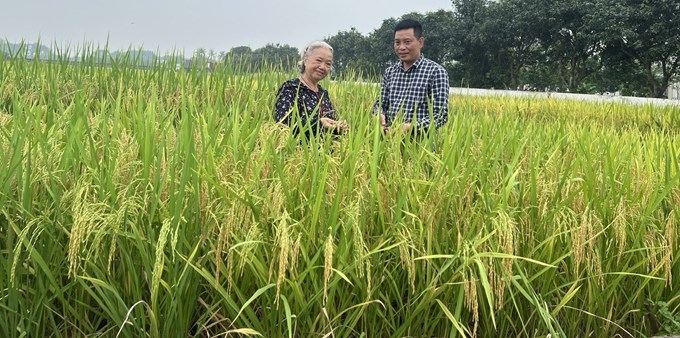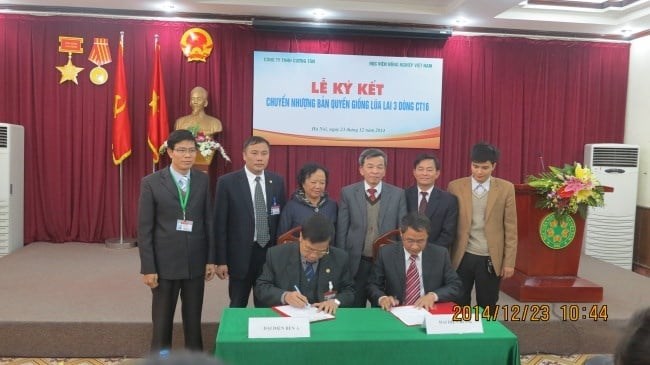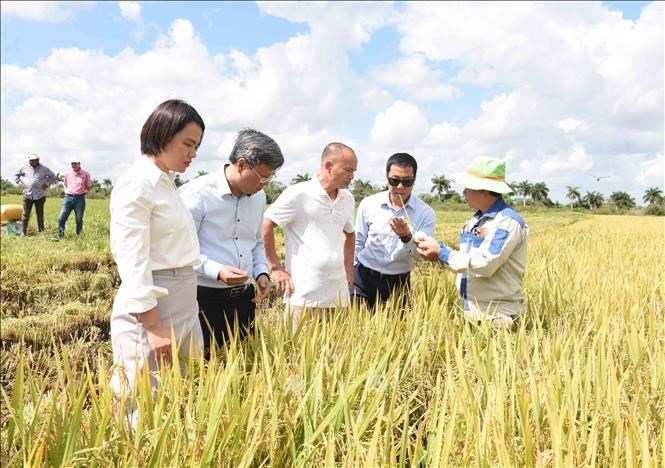A rice variety from Vietnam, cultivated by Cuban farmers, achieved yields twice as high as the local varieties currently grown in the country. This high-performing three-line hybrid rice variety, CT16, was developed by scientists from Vietnam National University of Agriculture (VNUA).
Surprisingly, the three-line hybrid rice variety from Vietnam, cultivated on Cuban soil, developed by scientists from Vietnam National University of Agriculture (VNUA) was thriving on Cuban Soil.
According to Decision No. 520/QD-TT-CLT dated December 30, 2022, issued by the Department of Crop Production (Ministry of Agriculture and Rural Development, now the Department of Crop Production and Plant Protection under the Ministry of Agriculture and Environment), the three-line hybrid rice variety CT16 was granted an extension of its circulation approval with the registration code CNLH.2022.187. The listed authors included Nguyen Thi Tram, Tran Van Quang, Pham Thi Ngoc Yen, Vu Van Liet, Nguyen Van Muoi, Tran Thi Minh Ngoc, and Vu Binh Hai, all from the Institute of Crop Research and Development, VNUA. The organization responsible for registering its circulation was Cuong Tan Co., Ltd. The variety was approved for cultivation during the late spring crop in northern provinces, from January 1, 2023, to December 31, 2032.

Assoc. Prof. Dr. Nguyen Thi Tram, one of the authors of the three-line hybrid rice vareity, CT16, inspects the high-yield experimental field in Cuba. Photo by VNUA
The CT16 variety was first recognized as a new plant variety in Vietnam in 2011.
In an interview with Dan Viet on October 24, Assoc. Prof. Dr. Nguyen Thi Tram, Labor Hero and one of the principal breeders of CT16, now gaining attention in Cuba for its superior productivity compared to local Cuban varieties, expressed both surprise and pride that a rice variety developed by her and her colleagues had contributed to such a remarkable achievement abroad.
Assoc. Prof. Dr. Tram recalled that in 2008, after VNUA’s research team sold the patent for the two-line hybrid rice TH3-3 to Cuong Tan Co., Ltd., the company’s leadership expressed concern that the two-line hybrid could only be produced during the summer–autumn season in northern Vietnam. To produce seeds during the spring crop, they needed to move production to the warmer central provinces.
“Therefore, Cuong Tan wanted a three-line hybrid variety that could be grown during the spring season in the north and placed an order with our research team at VNUA to develop a rice variety suitable for both the spring and summer–autumn crops”, Dr. Tram explained.
After receiving the “order”, Assoc. Prof. Dr. Tram and her team began crossbreeding to create the new rice variety. “At that time, I was supervising a master’s thesis and decided to direct the research toward developing a three-line hybrid. We used Nhi Uu 838 as the female line and R16 as the male line. The resulting hybrid showed strong heterosis — excellent yield and quality equivalent to Nhi Uu 838, but with stronger stems, denser grains, and better cold tolerance. After field trials, it was recognized as a national variety, and the company named it CT16 to begin commercial production during the spring crop”, she shared.

Signing ceremony of the technology transfer for CT16 between VNUA and Cuong Tan Co., Ltd. in December 2014. Photo by VNUA.
Assoc. Prof. Dr. Tram, the author of many high-yield hybrid rice varieties, added that developing “Made in Vietnam” hybrid rice varieties, with full control over parent lines and F1 hybrid production technology, was one of the national agricultural priorities at that time. While many other institutions were also engaged in hybrid rice breeding, VNUA’s team chose a Chinese female line as a parent, which produced excellent results, high yield and stable performance in Vietnam’s summer–autumn season, achieving 7–8 tons/ha.
Accordingly, the CT16 variety has a growing duration of 125–135 days for the spring crop and 100–115 days for the summer–autumn crop. It can be cultivated twice a year, yielding 7–8 tons/ha per crop, with moderate resistance to major pests and diseases, good lodging resistance, and high cold tolerance. F1 seed production yields 3–3.5 tons/ha.
“Because of its high productivity, strong stems, and resistance to pests, this rice variety is especially suitable for countries facing food security challenges and difficult cultivation conditions like Cuba”, Dr. Tram noted.

The rice field with outstanding yield cultivated by Vietnamese firm in Cuba. Photo by TTXVN.
Vietnamese rice achieves outstanding yields in Cuba
In September 2024, during the State visit of General Secretary and President To Lam to Cuba, a cooperation agreement was signed in which Vietnam committed to supporting Cuba in rice production. Following the government’s directive, Vietnam dispatched a team of agricultural experts and donated several Vietnamese rice varieties for trial cultivation, and the three-line hybrid CT16 developed by VNUA’s hybrid rice research group was among the selected varieties.
In Cuba, the Vietnamese team planted CT16 on 16 hectares in Los Palacios District, Pinar del Río Province. Using advanced cultivation techniques, the CT16 fields achieved double the yield compared to Cuba’s traditional rice varieties.
According to Mr. Pham Ngoc Tu, Head of the Vietnamese expert team, combining Vietnamese rice varieties such as CT16 with improved cultivation practices could help Cuba achieve yields of 7–8 tons/ha, much higher than the 3–4 tons/ha typically obtained from local varieties.